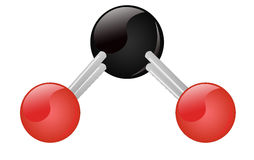Properties of Carbon Dioxide (CO2)
Properties of CO2

Physical properties of CO2 :-
Carbon dioxide is a colorless & odorless gas. It is soluble in water, ethanol , acetone and has the following properties :
- Melting Point : -55.6 degC
- Boiling Point : -78.5 degC
- Density : 1.977
Chemical properties of CO2 :-
- Carbon dioxide is a linear covalent molecule.
- Carbon dioxide is an acidic oxide and reacts with water to give carbonic acid.
- CO2 + H2O ==> H2CO3
- Carbon dioxide reacts with alkalis to give carbonates and bicarbonates.
- CO2 + NaOH ==> NaHCO3 (Sodium BiCarbonate )
- NaHCO3 + NaOH ==> Na2CO3 (Sodium Carbonate) + H2O
Uses of CO2
- It is used to neutralize alkaline water.
- Carbon dioxide is used as an additive to oxygen for medical use as a respiration stimulant
- Liquid Frozen Carbon Dioxide (Co2) is a good solvent for many organic compounds.
- Liquid Frozen Carbon Dioxide (Co2) is used as a propellant in aerosol cans, it replaces more environmentally troublesome alternatives
- It is used for refrigeration and cooling.
- It is used as an inert gas in chemical processes, in the storage of carbon powder and in fire extinguishers.
- It is used in solid as well as in liquid form
- It is used in metal industry in the formation of casting molds to enhance their hardness
- Carbon dioxide gas is used to carbonate soft drinks, beers and wine and to prevent fungal and bacterial growth.
- Large quantities are used as a raw material in the chemical process industry, especially for methanol and urea production.
- It is used in oil wells for oil extraction and maintain pressure within a formation
- Liquid or solid carbon dioxide is used for quick freezing, surface freezing, chilling and refrigeration in the transport of foods etc.
Material Safety Data Sheets (MSDS) of CO2
Hazards Identification:
- Emergency Overview: Amber glass bottle packed inside a cardboard box. Clear, orange colored solution with camphor like odor. May cause eye irritation. For eyes-only.
- Eye: May cause temporary stinging, burning and conjunctival redness.
- Skin: May cause irritation, dermatitis and hypersensitivity in some individuals
- Ingestion: May cause irritation and hypersensitivity in some individuals. Will produce a yellow or green discoloration to the mouth.
- Inhalation: Aspiration of the medication may produce irritation and hypersensitivity in some individuals.
- Chronic Effects: Prolonged use may delay wound healing and is not recommended.
- Target Organs: Eyes, skin and central nervous system.
- Medical Conditions Aggravated by Long Term Exposure: This preparation should be used cautiously and sparingly in patients with cardiac disease, hypothyroidism or allergies.
First Aid Measures:
- Skin: Remove all contaminated clothing and wash skin with copious amounts of water for at least 20 minutes. Contact physician if skin becomes irritated.
- Eyes: Rinse immediately with copious amounts of water for at least 20 minutes. Contact a physician.
- Inhalation: Remove person to fresh air, and if breathing stops, use artificial respiration. Contact physician.
- Ingestion: Wash out mouth and drink plenty of water and bland fluids. The use of an emetic drug and/or gastric lavage is advisable. Do not give anything to an unconscious person. Contact physician.
Fire Fighting Measures:
- Hazardous Products: Emits toxic fumes, nitrogen oxides (NOx), carbon monoxide (CO) and carbon dioxide (CO2).
- Fire Fighting Instructions: Wear self-contained breathing apparatus and protective clothing. Use water spray to keep fire-exposed containers cool. Do not spray water into the burning material.
- Extinguishing Media: Dry chemical, carbon dioxide, halon, water spray or fog, and foam on surrounding materials.
Accidental Release Measures
- Large/Small Spills: Use personal protective equipment. Contain the spill to prevent drainage into sewers, drains or streams. Use absorbent material to solidify the spill. Shovel up solidified waste.
Handling and Storage
- Handling: Avoid contact with product and use caution to prevent puncturing containers. No special protective equipment or procedures are required in the clinical or home environment.
- Storage: Store product upright in original containers with the cap tightly closed at a controlled room temperature 150-300 C (590- 860 F).
KEEP THIS OUT OF THE REACH OF CHILDREN.
